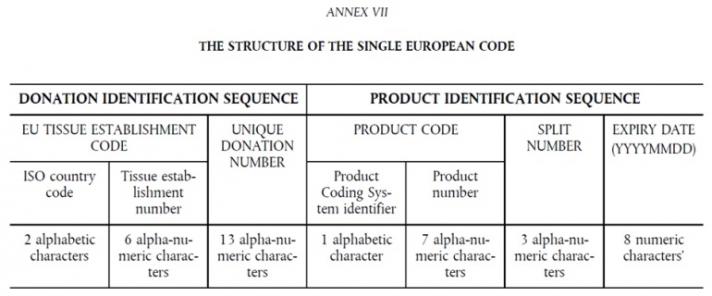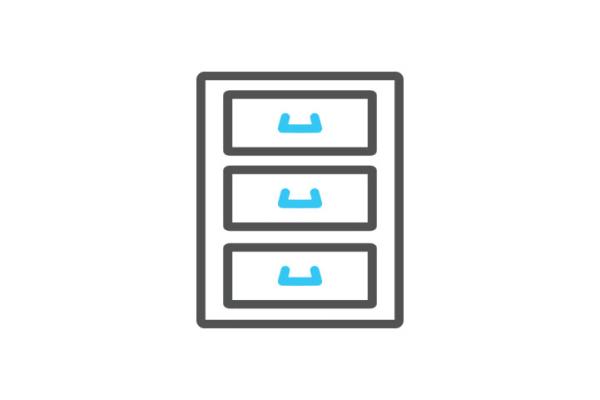In the European Union human tissues and cells intended for human application need to be traceable from the donor to the recipient and vice versa (so-called 'traceability').
To help with this a unique identifier, called the Single European Code (SEC), has been introduced and, together with the accompanying documentation, it should support traceability and provide information on the main characteristics of such tissues and cells.
By entering the SEC into a Commission-hosted publicly accessible IT platform, users be able to retrieve relevant information on the tissue and cell product itself and on the associated tissue establishment, including the activities for which it is authorised, by tissue and cell type, and its contact details. This is essential information for end-users in the field.
1. Legal requirements
Commission Directive (EU) 2015/565 amended Directive 2006/86/EC as regards certain technical requirements for the coding of human tissues and cells and was published on 9 April 2015.
Directive 2006/86/EC as amended ('The Directive') thus lays down the obligation for tissue establishments to affix a "Single European Code” or “SEC” on tissues and cells distributed for clinical application in the EU. The Directive also sets out the requirements for its application (including exceptions) and general obligations of the tissue establishments, competent authorities and the European Commission.
The "Single European Code” or “SEC” is a unique identifier that consists of two parts, a donation identification sequence, essentially indicating the origin of the tissue or cells, and a product identification sequence, essentially classifying the type of tissue or cells.
Further details are specified in Annex VII to the Directive (see below).
The SEC shall be applied to all tissues and cells distributed for human application except in the excluded circumstances described below. For the other situations where tissues and cells are released for circulation (i.e. transfer to another operator for further processing, with or without return), as a minimum the donation identification sequence shall be contained at least in the accompanying documentation.
The following situations are excluded from the application of the SEC:
- reproductive cells from partner donation;
- tissues and cells distributed directly for immediate transplantation to the recipient, as referred to in Article 6(5) of Directive 2004/23/EC;
- tissues and cells imported into the Union in case of emergency authorised directly by the competent authority or authorities, as referred to in Article 9(3)b of Directive 2004/23/EC.
Member States may also allow exemptions from the application of the SEC for:
- tissues and cells other than reproductive cells for partner donation, when these tissues and cells remain within the same centre;
- tissues and cells that are imported into the Union, when these tissues and cells remain within the same centre from importation to application, provided that the centre comprises a tissue establishment authorised, designated, accredited, or licensed to carry out importing activities.
Tissues/cells imported from third countries for distribution in the EU should also be labelled with the SEC unless they are imported directly to the centre where they will be applied to a patient. The importing tissue establishment is responsible for the application of the SEC on the product and in the accompanying documentation (double coding/labelling with both the original code and the SEC).
When the system was created, a number of product coding systems already existed in the EU. In addition to a newly created coding system (EUTC), two organisations (ICCBA and Eurocode) are allowed to maintain and use their codes as part of the SEC.
2. Transposition and implementation calendar
Member States are required to transpose the provisions of Directive (EU) 2015/565 into their national legislation by 29 October 2016.
Member States should apply the requirements on the SEC from 29 April 2017.
3. Transitional period
According to Article 10d in Directive 2006/86/EC as amended, tissues and cells already in storage on 29 October 2016 shall be exempted from the obligations relating to the SEC, provided the tissues and cells are released for circulation in the Union within five years following that date (i.e. before 29 October 2021) and under the condition that full traceability is ensured by alternative means.
For tissues and cells which remain in storage and which are only released for circulation after the expiry of this five-year period (i.e. after 29 October 2021) and for which the application of the Single European Code is not possible, in particular because the tissues and cells are stored deep-frozen, the tissue establishments shall use the procedures applicable to products with small labels (i.e. where the label size precludes the application of the SEC on the label, the code shall be unambiguously linked to tissues and cells packaged with such a label through the accompanying documentation).
All tissue and cell products processed and stored after 29 April 2017, including those to be stored for long periods (e.g. deep-frozen) need to respect the requirements on the application of the SEC.
Guidelines for competent authorities and tissue establishments on the implementation of the Single European Code (SEC) for tissues and cells:
The link to the EU Coding Platform is available here: https://webgate.ec.europa.eu/eucoding/.
The EU Coding platform will allow public, free of charge access to the EU Tissue Establishments Compendium and the EU Tissue and Cell Product Compendium.







